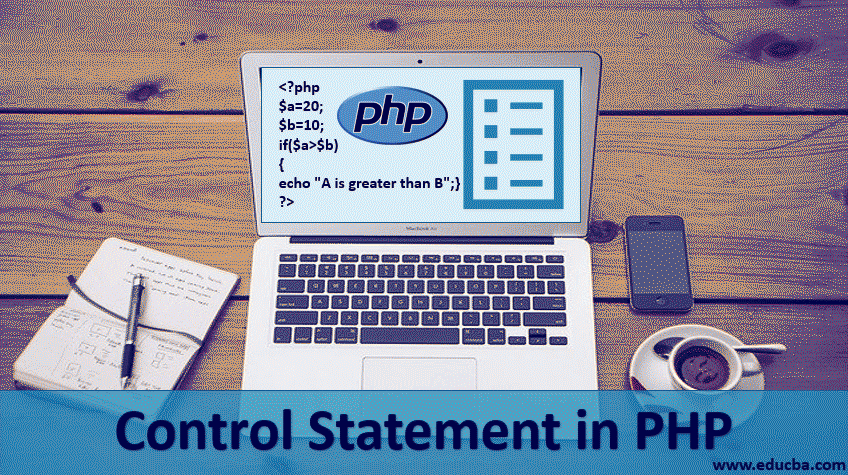Updated May 8, 2023

Introduction to Control Statement in PHP
Control statements are a basic component of all modern-day programming languages like PHP, Java, Python, Go, Ruby, NodeJS. These control statements allow software developers and architects to decide how the software or program they develop will behave under different conditions. For instance, on an e-commerce platform, the developers would want the same system to behave differently for different user roles like buyers as well as sellers. Such kind of distinguished behaviors can only be achieved with control statements.
Different Control Statement in PHP
Like all other languages, PHP provides a few control statements enabling developers to develop different logic to execute in different conditions. PHP core includes the control statements:
- if
- if.else
- if.else..if
- Switch statement
Let us look at each of these control statements with details and understand their implementation through examples.
1. The IF Statement in PHP
The IF statement in PHP is the most simplified control statement of the language. The IF condition works on a Boolean value which is evaluated based on a certain condition and it is used to execute certain lines of code only if a condition is met or is true. The condition provided to the IF statement is first to evaluate, depending on the evaluation a False or True value is generated and on basis of it the code if the IF condition block is either executed or skipped in the program flow.
Let’s walk through the syntax of if statement to understand it better:
if (my_condition) {
code to execute if the condition supplied is true;
}As shown above, the if statement requires a condition in the () round brackets which should be evaluated. In the curly braces, {} we supply the code spec which should be executed.
Let’s see an example below:
Code:
<?php
$a=20;
$b=10;
if($a>$b)
{
echo "A is greater than B";
}
?>Output:
2. The IF-ELSE Statement in PHP
As mentioned before, the IF statement provides a very basic program control. The IF-ELSE statement adds further complexity to the IF statement by defining 2 blocks of code; one to be executed when the condition stands true and other when the condition evaluates to false. Naturally, since the condition can either evaluate to true or false either the code block in IF would execute or the code block under ELSE would execute. Under no circumstances, both blocks will execute parallel.
Let’s review it’s syntax below:
if (condition top evaluate) {
code to executed if the condition supplied is true;
}
else
{
code to execute if the condition supplied is false;
}Let’s understand it’s implementation with an example:
Code:
<?php
$a=20;
$b=10;
if($a>$b)
{
echo "A is greater than B";
}
else
{
echo "B is greater than B";
}
?>Output:
Now, when the values of $a and $b are switched in the above code as shown below:
Code:
<?php
$a=10;
$b=20;
if($a>$b)
{
echo "A is greater than B";
}
else
{
echo "B is greater than A";
}
?>Output:
3. The IF – ELSE–IF Statement in PHP
Sometimes a need may arise to use multiple if conditions together, in such cases we can use a combination of multiple if-else statements. We can combine several if-else statements to work together as long as our requirement is met.
The syntax of if-else if combination statement would be as follows:
If (condition1)
{
Code to execute;
}
elseIf(condition2)
{
Code to execute if condition 2 is met;
}
Else
{
Code to execute if condition1 and condition2 are not met;
}Let’s understand this better with an example:
Code:
<?php
$t = date("H"); //collecting the date from server
echo "The time is " . $t;
echo ", and we will show the following message:";
echo "\n";
if ($t < "10") { //condition 1
echo "Hello! I hope you have a good morning!";
} elseif ($t < "20") { //condition 2
echo "Hello! I hope you have a good day!";
} else {
echo "Hello! I hope you have a good night!";
}
?>Output:
4. Switch Statement in PHP
The Switch Statement or generally known as a switch loop is a very efficient way to work with multiple conditions simultaneously. It allows us to achieve the same functionality as if-else if and else does but can be achieved with lesser lines of code.
Syntax:
switch (condition) {
case value1:
code to be executed if n=label1;
break;
case value 2:
code to be executed if n=label2;
break;
case value 3:
code to be executed if n=label3;
break;
...
default:
code to be executed if n is different from all labels;
}The Switch statement first evaluates the “condition” and then executes the code in the block with corresponding label value. If none of the label values match the condition, it executes the code in the default block.
Now let’s understand the flow of the switch statement with the below practical example:
Code:
<?php
$myfavsport = "cricket";
switch ($myfavsport) {
case "cricket":
echo "Your favorite sport is cricket!";
break;
case " football":
echo "Your favorite sport is football!";
break;
case "throwball":
echo "Your favorite sport is throwball!";
break;
default:
echo "Your favorite sport is neither cricket, football or throwball!";
}
?>Output:
Conclusion
With the help of the above examples, we can understand how different control statements in PHP work. The developers may choose the control statement to us depending on the logical flow they would like to define in the code. The control statements are the defining blocks of a software system. The better control statements provided by a language to control the execution and logic flow of the application the more suitable it is to build complicated software.
Recommended Articles
This is a guide to the Control Statement in PHP. Here we discuss the different conditions of PHP along with examples and its code implementation. You may also look at the following article to learn more –


